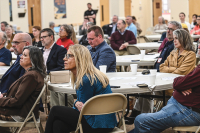New nesters
I believe all of my feathered friends that nest and raise families in my yard and in the woods surrounding my yard are once again setting up housekeeping. That includes the year round residents like downy woodpecker, red-bellied woodpecker, pileated woodpecker, yellow-shafted flicker, Carolina chickadee, American robin, tufted titmouse, song sparrow, northern cardinal, Carolina wren, eastern towhee, brown creeper and eastern phoebe.
Neotropical migrants that have returned include hooded warbler, northern parula – which nested for the first time last year and is back this year – blue-headed and red-eyed vireo, ovenbird, wood thrush, black-and-white warbler, scarlet tanager and red-breasted grosbeak.
I have had broad-winged hawk flyovers and assume they will once again nest in the woods around the house as they have for the last several years. And new to the mix this year is a pair of barred owls.
We have always heard the occasional barred owl in the distance. But about a month or so ago we had a pair really near the house. You could tell it was a pair because the male’s voice is lower pitched than the female. It became apparent after a couple of weeks that these two had taken up residence, and we hear them almost daily now.
The variety of vocalization is truly amazing. The standard barred owl call is an eight-note “who cooks for you, who cooks for you-all” which frequently has a gurgled or slurred “you-all” at the end. When a pair decides to establish a territory and set up housekeeping there is a cacophony of calls. A lot of the territorial and/or challenge calls are a series of one-note “whos” followed by a “you-all” at the end. This call is predominantly the domain of the male but the female joins in from time to time.
When a pair engages in a round of simultaneous calling it can really get raucous with eight-note and one-note calls mixed together, occasionally joined by a series of caws and some plain crazy sounds. It is neither a duet nor a call and response kind of event. It is more like Joe Cocker and Aretha Franklin simultaneously singing different songs and trying to out do each other.
Related Items
Some calls are more commonly associated with one or the other sex, for example males are more likely to perform the “series” call while the one-note call and whistles are more commonly performed by the female. However, either sex is capable of emitting any of the calls. The male (noted by the lower pitched call) of the pair in our woods was heard repeatedly this past weekend giving the one-note call.
This auditory performance will, hopefully, be enhanced in a few weeks by the screeching begging calls of juveniles. To get an earful of barred owl calls check out http://home.centurytel.net/bobowlcalls/Barred_Owl_calls.htm.
Don Hendershot can be reached at This email address is being protected from spambots. You need JavaScript enabled to view it.









